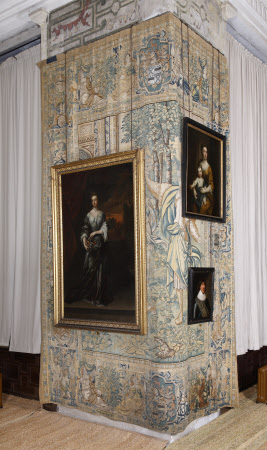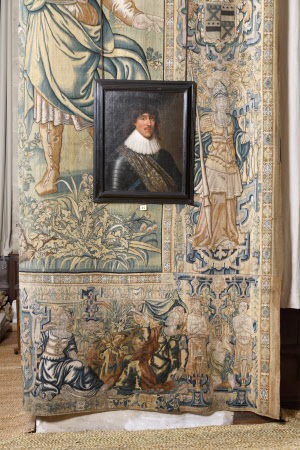The Children of Israel cry out to the Lord
Unknown Oudenaarde weaver whose mark is a six-pointed star
Category
Tapestries
Date
1578
Materials
Tapestry, wool and silk, 5-6 warps per cm
Measurements
5800 mm (H); 4350 mm (W)
Place of origin
Oudenaarde
Order this imageCollection
Hardwick Hall, Derbyshire
NT 1129447.1
Summary
Tapestry, wool and silk, 5-6 warps per cm, The Children of Israel cry out to the Lord, from a set of 13 of the Story of Gideon, Oudenaarde, 1578. This is the first tapestry in the narrative series. A man in a tunic and a turban stands on the right hand side, his right arm raised and pointing to the sky, while on the left there is a crowd of people outside a building wringing their hands, including a woman who lies weeping on the ground. In the background on the right there are burning houses, and a man running with a stick. On its own the subject of this tapestry could be one of two episodes: either the people are the Children of Israel, who at the beginning of the story of Gideon were persecuted by the Midianites (Judges 6.1-7); or alternatively they could be the people of Succoth, whom Gideon punished when they refused to feed his followers (Judges 8.16-17). A related tapestry at Chateaûdun helps to clarify the subject, as it includes an extra episode on the left hand side (what would be the right in the Hardwick version). At the far side is an angel sitting under an oak tree and between the angel and the standing man is a distant landscape with men and soldiers driving sheep and cattle. This serves to locate the scene near the beginning of the story. The men with sheep and cattle represent the Midianites who had overrun the land of the Israelites and left no sustenance for them, bringing in their livestock who ate everything (Judges 6.5). Their poverty caused the Children of Israel to ‘Cry unto the Lord’, and he sent them a prophet – the man pointing to the sky – who rebuked them for their disobedience (Judges 6.6-10). Finally an angel came and sat “under the oak which was in Oprah” and spoke to Gideon.
Full description
On its own the subject of this tapestry could be one of two episodes: either the people are the Children of Israel, who at the beginning of the story of Gideon were persecuted by the Midianites (Judges 6.1-7); or alternatively they could be the people of Succoth, whom Gideon punished when they refused to feed his followers (Judges 8.16-17). A related tapestry at Chateaûdun helps to clarify locate subject near the beginning of the story. Of Gideon, when the Midianites had overrun the land of the Israelites and left no sustenance for them, bringing in their livestock who ate everything (Judges 6.5). Their poverty caused the Children of Israel to ‘Cry unto the Lord’, and he sent them a prophet – the man pointing to the sky – who rebuked them for their disobedience (Judges 6.6-10). Finally an angel came and sat “under the oak which was in Oprah” and spoke to Gideon. Gideon is one of the seven Judges to appear in the Old Testament Book of Judges. The Israelites had fallen out of the way of God into the worship of false idols, and as punishment God allowed them to be attacked by the Midianites and the Amakelites. God called on Gideon, son of Joash, to deliver the people of Israel from the Midianites and to restore them to His worship. After asking God to give him a number of signs, most famously involving a leaving a fleece out in the dew, Gideon set about choosing his army from the people of Israel, who flocked to him; he submitted them to a number of tests to reduce their number to 300. Gideon and his army finally attacked the Midianite camp and routed them, chasing the survivors into the hills. Once the Midianites had been definitively defeated the people of Israel asked Gideon to be their King but he refused, saying that only God could rule over them. Gideon lived the rest of his days in peace and had 70 children; after his death though the Israelites fell once more into false worship. The design of the Gideon series is based in part at least upon a series of thirteen tapestries bought on behalf of Cosimo I de’Medici in Brussels in 1561, and sent to Spain as part of the extensive furnishings accompanying his son, Francesco de’Medici, in courtship of Joanna of Austria (Meoni 2003, p. 39). Gideon was the biblical patron of the Order of the Golden Fleece, the order of chivalry of the Habsburg dynasty to which Joanna belonged. Three tapestries from the Medici series survive, two of which correspond to examples at Hardwick (Gaeto Bartelà 1980, cat. no. 111; Bisogni (ed.) 1990, pp. 283, 285). One of the ‘Gideon’ tapestries is woven with the date 1578. The series has long been thought to be woven at Oudenaarde, based on their quality and the design of the borders (van Ysselsteyn 1968; de Meûter 1998). This has recently been confirmed by the presence of a mark on the upper galloon of two of the tapestries in the form of a six-pointed star. Similar marks appear on three other known tapestry sets, one of which, a set of five ‘Large Leaf Verdures with the Labours of Hercules’ split between the Musée du Louvre, Paris and the Provinciall Paleis van Oost, Ghent, also bears the mark of the city of Oudenaarde (Delmarcel 1999, pp. 203-7; de Meûter et al. 1999, pp. 127, 131). The design, manufacture and history of the Gideon set are discussed in detail in Wyld 2012. (Helen Wyld, 2009)
Provenance
Woven in Oudenaarde c. 1578 for Sir Christopher Hatton, and presumably hung at Holdenby Hall; on Hatton’s death in 1591 inherited by his nephew Sir William Newport (Later Hatton); July 1592 purchased by Elizabeth, Countess of Shrewsbury for Hardwick Hall; thence by descent to Andrew, 11th Duke of Devonshire; acquired through the National Land Fund in 1956 and transferred to the National Trust in 1959.
Credit line
Hardwick Hall, The Devonshire Collection (acquired through the National Land Fund and transferred to The National Trust in 1959)
Makers and roles
Unknown Oudenaarde weaver whose mark is a six-pointed star, tapestry weaver
References
Van Ysselsteyn, 1968: G T van Ysselsteyn, ‘Karel de Grote te Rome een 16e Eeuwse Tapisserie’, in Miscellanea Josef Duverger. Bijdragen tot de Kunstgescheidenis der Nederlanden, 2 vols., Ghent 1968, vol. 2, pp. 787-793 Wingfield Digby and Hefford, 1980: George Wingfield Digby and Wendy Hefford, Victoria and Albert Museum: The Tapestry Collection, Medieval and Renaissance, London 1980 Gaeta Bartelà 1980 Giovanni Gaeta Bertelà, Palazzo Vecchio: committenza e collezionismo medicei 1537-1610, exh. cat. Florence 1980 Bisogni 1990 Fabio Bisogni (ed.), Il Palazzo della Provincia a Siena, Rome 1990 De Meûter, 1998: Ingrid de Meûter, ‘Flemish Tapestries of the 16th and 17th Centuries in Great Britain and their Connection with Oudenaarde’, Bulletin de liaison du Centre International d’Étude des Textiles Anciens [CIETA], 75 (1998), pp. 97-109 Delmarcel, 1999: Guy Delmarcel, Flemish Tapestry, Tielt 1999 de Meûter et al., 1999: Ingrid de Meûter, Martine Vanwelden et al., Tapisseries d'Audenarde du XVle au XVllle Siècle, Tielt 1999 Meoni, 2003: Lucia Meoni, ‘Gli arazzi fiamminghi nella collezione de’Medici’, in Koenraad Brosens (ed.), Flemish tapestry in European and American Collections: studies in honour of Guy Delmarcel, Turnhout 2003, pp. 37-47, 193-197 Brosens, 2008: Koenraad Brosens, European Tapestries in the Art Institute of Chicago, New Haven and London 2008 Wyld 2012: Helen Wyld, 'The Gideon Tapestries at Hardwick Hall', West 86th, vol. 19, no. 2 (Fall-Winter 2012), pp. 231-254


